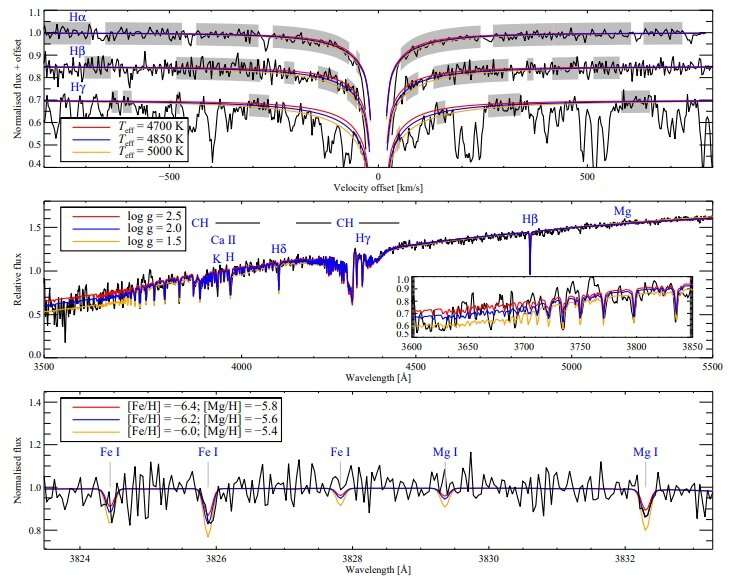April 25, 2019 report
New ultra metal-poor star discovered

An international team of astronomers has detected a new ultra metal-poor star with the lowest ever measured abundance of iron. Designated SMSS J160540.18−144323.1, the newly found object is the most iron-deficient star for which iron has been detected. The finding is presented in a paper published April 16 on the arXiv pre-print repository.
Metal-poor stars are rare objects as only few stars with iron abundances [Fe/H] below –5 have been discovered so far. Currently, SMSS J0313–6708, with metallicity below –7.3, is the most iron-poor star known to date. However, the most iron-poor star where iron has actually been detected is HE 1327−2326 with metallicity at a level of −5.7.
Astronomers are interested in expanding the still short list of metal-poor stars as such objects have the potential to improve our knowledge of the chemical evolution of the universe. The early evolution of the universe is believed to be dependent on the properties of the first generation of metal-free stars.
Searching for such stars using the SkyMapper telescope in Australia and spectrographs on other ground-based telescopes, a group of astronomers led by Thomas Nordlander of Australian National University, has identified a new addition to the list of stars with extremely low metallicities. The observations found that the star SMSS J160540.18−144323.1 (SMSS 1605−1443 for short), located in the Milky Way's halo, most likely some 36,000 light years away, has an ultra low abundance of iron.
"We report the discovery of SMSS J160540.18−144323.1, a new ultra-metal poor halo star discovered with the SkyMapper telescope," the researchers wrote in the paper.
The research found that SMSS 1605−1443 is a red giant branch star with an effective temperature of about 4,850 K, and has a remarkably low abundances of heavier elements, including an extremely low abundance of iron at a level of -6.2.
While chemical abundances of other elements of SMSS 1605−1443 turned out to be compatible with alpha-enhanced chemical composition typical of halo stars, the studied object showcases strong carbon enhancement. This, according to the study, suggests an enrichment from a Population III (the first generation of metal-free stars) mixing-and-fallback supernova.
"Population III stars exploding as fallback supernovae may explain both the strong carbon enhancement and the apparent lack of enhancement of odd-Z and neutron-capture element abundances," the astronomers noted.
In concluding remarks, the researchers underlined that SMSS 1605−1443 has the lowest metallicity among the stars for which iron has been detected, exhibits carbon overabundance, and that it does not show strong enhancement nor a strong abundance trend among elements heavier than carbon. Further observations of this star, studying higher-quality spectra, could deliver more detailed chemical analysis, what in result could provide more hints into the nature of its Population III progenitor star.
More information: T. Nordlander et al. The lowest detected stellar Fe abundance: The halo star SMSS J160540.18-144323.1. arXiv:1904.07471 [astro-ph.SR]. arxiv.org/abs/1904.07471
© 2019 Science X Network




















